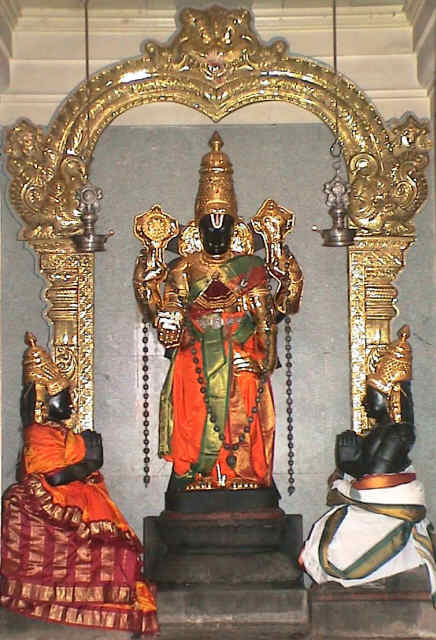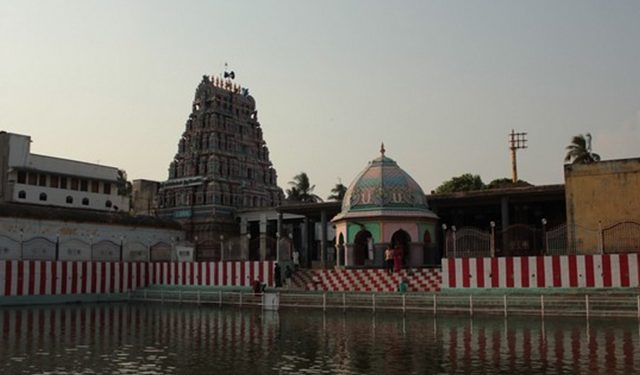Uppiliappan Temple, also known as Thiruvinnagar of Venkatachalapathy Temple is a temple dedicated to Hindu god Vishnu.It is counted as the 60th among the 108 Divya Desams dedicated to Vishnu.Vishnu is worshipped as Uppiliappan and his consort Lakshmi as Bhumi Devi.
Shrine’s History
It is not clear from the inscriptions and records as to when the temple was initiated, but there are inscriptions from the Medieval Cholas period indicating generous gifts to the temple. There are two inscriptions recorded from the Naganathar Temple in Tirunageswaram. The epigraph numbered 211 of 1911 on the northern wall of the central shrine indicates gift of gold jewel worked in gems and pearls to the temple from the Chola king Parakesarivarman alias Rajendra Chola I .
The second inscription numbered 218 of 1911 on the southern wall of the same shrine indicates a gift of land to the temple in the fourteenth year of the Chola king Rajaraja Rajakkesarivarman I. The tradition in many ancient temples in Tamil Nadu including the one in the temple is that the original image of the presiding deity is made of wood and replaced later with stone.There were the lot of additions made to the temple by Govinda Dikshitar, the minister of successive Nayak rulers, Achuthappa Nayak and Raghunatha Nayak . The temple is maintained and administered by the Hindu Religious and Endowment Board of the Government of Tamil Nadu.
Legends Associated with This Shrine
The temple is mentioned in the Brahmanda Purana, one of the eighteen famed Hindu scriptures. As per Hindu legend, once Tulasi did penance to attain closeness to Vishnu. Vishnu gave a boon to the plant that his consort Lakshmi would appear under her lap in Tiruvinnagaram. Tulasi appeared in the place where the temple is located. This is mentioned in the 53rd verse of Nammazhwaar in Thiruviruththam.
Markandeya Maharishi worshipped Vishnu and desired for the boon that Lakshmi should appear as his daughter and Vishnu himself should become his son-in-law. Once Markandeya was on a holy trip and after reaching Thiruvinnagaram, he felt that it was the right place for getting his desire fulfilled. Markandeya started a severe penance for thousand years seeking Lakshmi’s blessings. Lakshmi appeared as a baby under the already incarnated Tulasi plant. Markandeya felt the presence of Lakshmi as the incarnation in the form of the baby and realised that a part of his desire had been fulfilled.
He took possession of the baby and raised her. When the young girl reached the adolescent age, on the panguni month of Shravana, Vishnu appeared as an old man and asked for the hand of Markandeya’s daughter in marriage. Markandeya replied that “You are very ripe and old, my daughter is too young and she does not even know how to cook with proper salt contents” to which the old man replied, “If your daughter must cook without salt, then I will still take it as my best food, but I will not leave from here without marrying her”. Markandeya sought the help of Vishnu and then realised using his penance that the old man was none other than Vishnu himself. When he opened his eyes, Vishnu appeared in front of him with conch and chakram as in Vaikundam. Markandeya offered his daughter’s hand in marriage.
As per the legend, the temple Neyvethiyam is always prepared without salt in the food. The name Oppiliappan is as a result of this legend. There is also a story behind the tank in this temple. Once a King had consummated with a daughter of a saint and hence the saint cursed him to become a bird. The king lived as a bird and one night when there were a storm and the branch of the tree the bird was sleeping on broke and fell into the water of this tank. The bird which got dipped by this accident in the tank regained its original form as the King and since then this is known as the only theerththam that one can do theerth thaadanam even in the night. Since this tank has such a healing power in the day as well as night, it is called “Ahoraathra Pushkarani”.
The place is referred by various names like “Agasa Nagaram”, “Vaikunda Nagaram”, “Thiruvinnagar”, “Oppiliappan Sannithi” and “Uppiliappan Sannithi”. The presiding deity is referred by various names like Venkatachalapathy, Thiruvinnagarappan, Oppilaappan, Thanoppillaappan, Uppiliappan and Srinivasan.

Architectural Relevance of This Shrine
The temple has a five-tiered rajagopuram and enshrined within a granite wall. The complex contains all the shrines and water bodies associated with it. The Sahasradhari plate and pot are made of gold for performing Thirumanjanam to the presiding deity. The temple also maintains golden sword, diamond crown and gold arm guard for the image of Hanuman. The shrine over the sanctum is plated with gold.The main shrine of the temple houses the image of Oppiliappan in standing posture and it also houses the images of Bhoomidevi and sage Markendeya. The vimana is called Suddhananda, meaning “pure happiness”.
The Desika shrine is located near the sancturn Sanctorum. On the sides of the first precinct, the shrine of Anjaneya is located on the southern, and Always’ and Sri Rama’s on the northern and Ramanuja’s on the eastern sides.The shrine for Maniappan is located in the second precinct in the southern side, while the shrines of Ennappan and the holy birth spot of Bhoomidevi are located on the northern side. Garuda’s shrine is located right opposite the sanctum and right behind the temple mast. The shrine of dancing Krishna is located on the southern side of the main entrance. A marble hall is located on the western side in the inner precinct acts as the resting hall for the festival deities during festivals.
Dolotsavam festival is celebrated in Another marble hall on the northern side of the temple. Adjoining the hall, there is a shrine where the images of Rama, Lakshmana, Sita and Hanuman are housed. The sacred bedchamber called Tiruppalliarai, covered full of mirrors is located next to it.A Yaga sala for performing religious rituals is present in the temple. The temple has a hall for housing festival vehicles, a library, and a hall with edight carved pillars on the banks of the temple tank, where the annual float festival is celebrated. The Kodimandapa, located to the south of the Garuda shrine, is used for several day-to-day religious practises. The annual Kalyana Utsavam festival is performed in the hall amidst music and dance programmes.
Outside the main complex, the temple maintains two marriage halls, a rest house containing five rooms, two other halls, a housing each for the small chariot and the big chariot.There is a garden around the third precinct of the temple and a much bigger garden about 0.5 km to the south of the temple, where Tulasi and flowers are grown. A hall in the garden is used for resting deities during the Vasantotsavam festival celebrated for six days in May?June every year.
Shrine’s Map Location and How to Go There
By Road
There are regular government and private bus services to Chennai, Thanjavur, Mannargudi, Tiruchirapalli,Chidambaram,Nagapattinam,Coimbatore,Madurai,Pondicherry,andTirunelveli.
By Rail
Kumbakonam is connected by rail with most important towns and cities in South India. The Mysore- Mayiladuthurai Express connects Kumbakonam with Mysore and Bangalore. There are regular express trains that connect Kumbakonam with major cities in the state like Chennai,Coimbatore,Madurai and Tiruchirapalli.
By Air
The nearest international airport is at Tiruchirapalli, which is 91 km from Kumbakonam.
Shrine Timings
11A.M to 7 P.M
Events Celebrated at This Shrine
Chariot festival March or April
Vasanta Utsavam May or June
Pavitrotsavam August or September
Brahmotsavam September or October
Kalyana Utsavam October or November
Adhyayana Utsavam December or January
Float festival January or February
Extra Information About this Shrine
Nearby Temple
Adi Kumbeswara Temple
Ramaswamy Temple
Chakrapani Temple
Kasi Viswanathar Temple
Nageswaran Temple Sarangapani
Temple Someswar Temple
Swamimalai temple
Thiruvalanjuzhi Vinayakar Temple













































